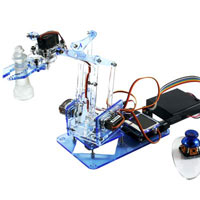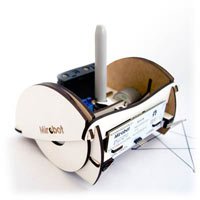Chassis Evolution
The chassis for Mirobot has changed quite a bit since I first started designing it. It’s now at a point where it actually works and I feel a lot more confident about using it with people other than myself. I’ve got two sets of the new one ready to be boxed up for Christmas for my kids now which was my driver for building it in the first place. We’ll have some fun soldering over Christmas. I was looking through the old chassis designs and thought it would be interesting to trace the design evolution from the first stages, where it just didn’t work, to now where it does. The changes are relatively minor but have had a massive impact on functionality.
Version 1

This was the first iteration and it performed horribly. The wheels were screwed on and driven from the edge by a stepper with a drive wheel but didn’t move very freely. The problems with this version were that the drive train didn’t really work at all and the servo wasn’t held down well and came loose. The pen arm worked well first time so long as the servo was held in place.
Version 2

The drive train didn’t work that well but because communications were through USB I couldn’t tell if it was just the drag on the lead or not. I tightened up the holes for the servo and attached the wheels slightly differently but neither worked particularly well.
Version 3

In this design I perfected the servo mount by tying it into the side plane. This is still what’s used in the current iteration. In this version I tried to make the wheels have more grip by applying some silicone around their edges, which should also have solved the problem of grip between the stepper and the wheel. It didn’t. At this point I gave up on this approach of using steppers to drive the wheels from the edge and started looking around for different motors. You can see the Arduino stepper shield that I was using before the custom PCB in this photo.
Version 4

I managed to find a nice, low-cost geared stepper motor which was able to just drive the wheel directly. This eliminated all of the drive train problems, which I’d been becoming increasingly concerned about because of the complexity. Doing this cut out 4 screws and a couple of elastic bands used to tension the motor against the wheel. This is the first version that was able to drive properly and draw a line. The only problem was in the distribution of weight, which was too far back. This caused too much friction on the rear caster wheel and was causing problems with turning.
Version 5

This is the most major change in form factor as it now has a shorter chassis because the battery pack and PCB are now mounted vertically to bring the weight more over the wheels. It also uses a cheaper caster wheel that just clips into the chassis which has also eliminated two screws. It’s now driving well. There’s still a little too much flex in the pen holder which makes it difficult to adjust accurately and tends to make it draw rounded corners slightly so I’m going to attack that next. I also took the opportunity to add a bit of bling with some text on the sides!
That’s us up to date with the current design. It’s been a very gradual evolution from the first design but it’s amazing how much of a difference each tweak makes to the overall functionality.

